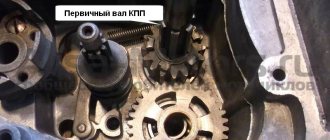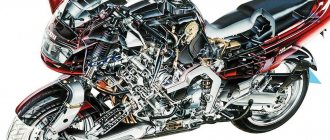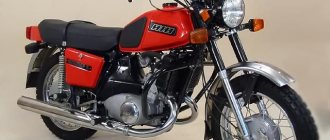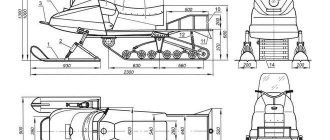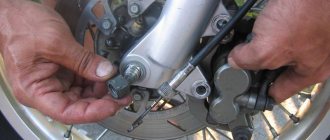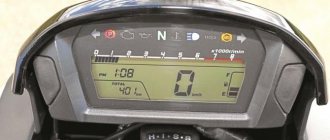Hello.
I came across an excellent article on motorcycle suspensions on the English-language Internet, I am posting its translation, since the information is presented simply, clearly and quite completely. The article is almost popular science, I don’t recommend it to hard-boiled theorists, but for those who want to understand the types of motorcycle suspensions without delving deeply into the details, it will be very useful. In fact, the most useful information for the average user has been collected.
Yes, and for owners of BMW motorcycles, this article will be of particular interest, since it has an entire paragraph devoted to the types of suspensions for motorcycles of this brand.
Background.
Suspension options for motorcycles are as varied as those for cars. Of course, the motorcycle only has two wheels, but this forces engineers to pay closer attention to the suspension. The most common type of motorcycle rear suspension is a swingarm with two shock absorbers or a swingarm with one shock absorber (monoshock). The most common front suspension option is a telescopic fork. Although, oddly enough, cruiser-style motorcycles that have no rear suspension at all are still common - the so-called “hardtail” (“dry frame” or “cracker”). In this case, the rear wheel axle passes through the frame. This is a kind of tribute to history, because until the 20s of the last century, the only thing that was between the road and the rider’s ass were the springs under the saddle and the tire pressure.
DIY making
A branded factory tool is a good and convenient tool for motorcycle repair. But the prices for such devices are quite high. It will also be quite difficult to choose a stand for a specific motorcycle model. Many companies offer universal stools. But, as practice shows, a universal tackle does not always have functions for a specific motorcycle.
In this case, you can make a motorized scooter with your own hands using drawings found on the Internet. A homemade lift can be perfectly adjusted to the size of your bike. It is quite simple to make, but it requires a lot of time and great care, since it must have ideal geometry. Otherwise, working with it will be quite problematic.
There are two ways to lift a motorcycle by the rear wheel. In the first case, lifting is carried out using a bushing installed in the wheel axle. In this position it is convenient to work with the chain.
In the second option, threads are made on the bushings and they are attached to the pendulum. In this position it is convenient to change wheels. When making the central frame of the tackle, you will need the help of a welder. All corners must be perfectly measured and welded securely. After all, safety and convenience during work depend on the accuracy of measurements and the quality of welding.
In conclusion, I would like to say that if possible, it is better to purchase a good branded option. If you are limited on money, then it is quite easy to make a motorcycle lift with your own hands. Drawings can be easily found on the Internet. A high-quality tackle will be an indispensable assistant in the repair and maintenance of your favorite bike.
In a nutshell about the geometry of the motorcycle.
Before you plunge into the murky world of technical terms outlined in this article, it would be useful to understand the basic logic of the suspension of any motorcycle. The following illustration shows the basic terms you will encounter.
Steering Axis - control axis; Rake Angle - “rake”, fork angle; Trail - “trail”, the distance on the ground between the wheel axis and a line extended from the axis of the steering column; Wheelbase - wheelbase, the distance between the axles of the front and rear wheels of a motorcycle.
Sportbikes have a small rake, which means the trail is also not great. A small trail gives less stability and stability, but it makes the motorcycle more easy to control and maneuverable. On the contrary, choppers, cruisers and customs have a large rake. More rake means more trail, which makes such motorcycles stable and stable in a straight line, but they are difficult to steer. Typically on motorcycles the rake fluctuates between 5 degrees. For example, the Yamaha R1 sportbike has a fork angle of 24 degrees, while the BMW K1200LT cruiser has a fork angle of 26.8 degrees.
Plunging when braking.
One of the drawbacks of telescopic forks is their tendency to compress when braking, causing the bike to nose-dive. Such bites depend most on the geometry of a particular motorcycle. When you brake, you slow the motorcycle forward. The force of inertia goes somewhere, and that “somewhere” is the front fork. Because the telescopic fork is at an angle to the vertical axis of the motorcycle and at an angle to the force vector pushing the motorcycle forward, some of that force compresses the suspension. Let's remember the school physics course. The force transmitted at an angle is equal to the main force multiplied by the cosine of the angle. Remember that the rake angle is calculated from the vertical axis? Therefore, the angle we are talking about is actually equal to the difference between 90° and the angle of the staff, that is, it is an additional angle to the staff. And since sine and cosine are mutually inverse functions, the cosine of the rake will be equal to the sine of the complementary angle. So for a rake of 25° degrees, we can use both the sine of the additional angle (65°) and the sine of the rake.
Look at the picture on the right and imagine that the rake of our motorcycle is 25°. Then the force that acts on the front fork of the motorcycle will be equal to the breaking force multiplied by the sine of the rake angle. For clarity, let's take a ridiculously small braking force of 1 Newton. Then our calculation will look like this: 1*sin(25)=0.4226 or 42.26%. That is, 42% of the braking force is distributed to the fork and puts pressure on the springs and oil. Now let's plug in the real numbers. Let's imagine that your weight is 100 kg, and the motorcycle weighs 165 kg. Braking force = mass*acceleration. By pressing the brake, you can easily achieve a deceleration of 1G, that is, 9 m/s?. In this case, the braking force is: 265 kg * 9 m/s? = 2385 newtons. If 42% of this force is applied to the springs and oil of the motorcycle, the fork has to cope with a force of about 1000 Newtons, which is equal to 100 kg. weight. It's like you're putting your entire body weight on the fork of the motorcycle - that's why we feel the dive.
The first shot in the war against dives was fired by the Honda concern, when in 1969 the engineers of this company developed the TRAC (Torque Reactive Anti-Dive Control) system, but it was used in the design of individual motorcycles until the 80s of the last century. In those days, the front fork hydraulics of a motorcycle interacted with the brake hydraulics and is best remembered for the Kawasaki GPZ900R, whose anti-dive system was called AVDS (Automatic Variable Damping System).
AVDS consisted of an additional hydraulic cylinder located at the bottom of each fork leg and connected to the calipers. The idea was to use the brake fluid pressure generated in the calipers to close the fork oil valve via a plunger, thereby increasing fork stiffness. A stiffer suspension reduced dive.
It sounded good, but many people disliked this system for one feature of the motorcycle’s behavior on bad roads. When braking on a rough road, riding a motorcycle was more like falling down a flight of stairs, since all the unevenness of the road was transmitted through the rigid fork to the motorcycle frame and, of course, to the rider. This also created an increased load on the motorcycle fork seals, which led to the need for their frequent replacement. Since then, these childhood diseases have been eliminated, and the developments of those years are often used in the design of forks of modern motorcycles.
TRAC.
Honda's TRAC system was somewhat different from Kawasaki's AVDS. According to Honda, hydraulic systems have two main disadvantages. Firstly, the additional hydraulic line gave the brakes a “wet” effect. Secondly, such systems are interdependent on each other. So Honda engineers decided that their system should be actuated by rotating the brake caliper itself. This made the system completely independent of the brake circuit. The brake calipers were not rigidly fixed to the feathers, but were located on movable brackets. When you press the brake, the friction force that arises between the brake pads and brake discs moves the calipers, the caliper presses on the anti-dive system valve installed directly in the motorcycle's seatstays. The Yamaha and Suzuki systems worked in approximately the same way, but the Honda system differed favorably from its competitors in that it worked tolerably on rough roads. The thing is that the TRAC system valve was floating and held in place by a spring. Thus, when hitting a bump, the oil had time to fill the space behind the valve, which actually turned off the system. Smart, right?
We continue the series of articles on electronic systems of modern motorcycles. You can find the previous ones in my posts. This time it’s time to talk about electronic suspensions. The topic is quite complex, a detailed description would be a whole monograph with a lot of mathematics, so I will greatly reduce and simplify it, focusing mainly on practical aspects.
First, let’s figure out what “electronic suspension” is and what electronics have to do with it. Moreover, in this area there is a certain confusion in the names: sometimes it is “electronic”, sometimes “adaptive”, sometimes “active”, or something else like that. Generally speaking, electronics in suspensions can be applied in many different ways, creating several very different types of electronic suspensions:
- Electronically adjustable suspension.
- Semi-active suspension, also known as adaptive.
- Active suspension..
Let's start with the simplest thing, namely the electronically adjustable suspension . This is actually a regular adjustable suspension, but instead of manual adjustment, electric drives are used, which are controlled by an electronics unit. This is the simplest and most common option; its typical representative is the BMW ESA. According to the principle of operation and the principle of regulation, such a suspension is no different from a regular one, but in order to change its settings, you do not need to twist it with your hands, you just need to press a couple of buttons. Most often, the settings of such a suspension are tied to the riding modes of the motorcycle, and you can also select the load, for example, riding with a passenger. There are no additional sensors, except for the actual position sensors of the regulators, and they are not needed. This suspension is quite convenient, but in its properties and range of adjustment it is no different from the usual one. The adjustment is quite slow, and sometimes you can hear the drive whirring. Most often, such a suspension is not adjusted smoothly, but by predetermined “steps”, which can be linked to other modes of the motorcycle, or to preset load gradations, such as one, with luggage, with a passenger, with a passenger and luggage. But if you go into the menu, you can set the suspension more precisely (not on all motorcycles).
It works something like this, using ESA as an example:
It can be seen that all the adjustments are in their usual places, but instead of manual knobs, servos are installed, the large one is engaged in preloading, where a large torque is needed, and the smaller engines regulate the compression and rebound damping. This big drive is buzzing with its gearbox.
The ESA works great on Gus, and its different positions feel very good. It’s convenient, you’re driving along the highway, you set some settings, then you drive onto the dirt, you don’t even have to stop for this.
But we must understand that the electronically adjustable suspension does not provide anything other than convenience. However, many motorcyclists are lazy and never adjust the suspension, which is always in a certain average position set from the factory. For such a person, electronic regulation can help to use the motorcycle more fully, because anyone can press a couple of buttons, and often nothing needs to be done at all, just switch the riding mode, and the suspension will come to the most suitable position for this mode.
But, as you yourself understand, there is no special magic in the electronically adjustable suspension. In order to add this very magic to the pendant, you need to do something much more complex.
Ideally, of course, you need to completely get rid of the standard scheme of a damped elastic element, and make sure that the suspension ceases to be an oscillating system. Instead, the position of the unsprung mass must be controlled directly, causing it to follow all road irregularities completely, and keeping the sprung masses more or less stationary. In fact, you need to make a regular stabilizer, approximately the same as what stabilizes, for example, the position of a tank gun. Or a video camera lens. That is, make an active suspension .
This can be achieved by placing some fairly fast and powerful linear motor (actuator) between the unsprung and sprung masses. If you supplement it with an accelerometer on the sprung mass, and include this accelerometer in a negative feedback loop that will control the force on this actuator, you can (in theory) achieve very good suspension performance in all road conditions and in all situations. The control system will control the force by simply trying to zero out the vertical accelerations of the sprung mass, and minimal accelerations of the unsprung mass is the main task of the suspension, as such.
Such an actuator can be hydraulic, that is, essentially an ordinary hydraulic cylinder. Naturally, this will require a fairly powerful hydraulic pump and a fairly fast-acting valve system. Such a system may not even be electronic, but purely mechanical, and such systems have been known since the 50s. Of course, one actuator is not enough (its ability to handle small irregularities is limited by the speed of both the actuator itself and the delays of the control loop), so an additional elastic element, for example a spring or an air cushion, is also installed. The interesting thing here is that this elastic element can be installed not directly, but as a hydraulic accumulator.
You can also install an electric actuator, such as in maglevs.
The active suspension actuator can (theoretically) be installed in place of all other elements, such as the elastic element and damper. But in practice it usually works either in series or in parallel with “regular” elements, and serves to add the right impulse at the right moment. There are a huge number of different schemes that allow you to apply external energy to the suspension, but they are all quite cumbersome and complex, so they are relevant mainly for cars.
Active suspension has a lot of advantages and can work just perfectly, better than any other type of suspension. In addition, it can perform additional functions, for example, raising and lowering the body of the vehicle, leveling it, tilting it for ease of boarding and disembarking, and much more.
There are also many disadvantages. Firstly, such a suspension is very large and heavy, since in addition to the actuator itself, it also requires a fairly powerful source of energy for its operation. This energy itself must also come from somewhere. This suspension is also quite complex, and of course, due to its complexity, it is not very reliable.
For motorcycles, active suspension is too heavy and requires too much energy, so it is not used. However, all is not lost for motorcyclists, because in addition to true active suspension, there is also a semi-active, or adaptive, design.
The mechanical design of a semi-active suspension is practically no different from a conventional one, and in the same way contains an elastic element and a damper that can dampen compression and rebound. And just like in an electronically controlled circuit, adjustment of preload and damping is carried out using electric drives. Mechanically, a semi-active suspension is generally almost no different from an electronically adjustable one, and, as a rule, semi-active suspensions are made on the basis of conventional electronically adjustable suspensions.
The basic principle of operation of a semi-active suspension is generally clear from its second name, but we remember that it is adaptive. If you equip the suspension with acceleration sensors for sprung and unsprung mass, as well as a damper rod position sensor, then at any time you can get fairly complete information about what is happening both with the suspension and with the vehicle in general. If you constantly analyze this information, you can dynamically select suspension settings based on current driving conditions. This is, in fact, adaptation.
Of course, in order for the adaptation to work well and be useful enough, the response of the suspension adjusters must be fast enough. This is usually not necessary for preloading (and it can't be done quickly anyway without using overly powerful drives), but the damping adjustment should be quite quick.
This adjustment can be made in two ways. The first is a dynamically controlled valve system, which operates in much the same way as conventional control, only faster.
There is a second way - you can dynamically change the viscosity of the fluid itself in the damper, taking advantage of the fact that there are magnetorheological fluids that change their viscosity depending on the magnetic field strength. It sounds complicated, but in fact it is just a suspension of small (very small) magnetized balls in oil. If you pour such liquid into a regular shock absorber and put an electromagnet coil on it, you can get a shock absorber that will change its characteristics over a very wide range, simply following the current strength in this coil.
Motorcycles use a hydraulic dynamic control circuit, the basis of which is a fairly conventional conical valve controlled by a solenoid. Depending on the position, it changes its throughput, and thereby can adjust the damping. The spring preload is adjusted as usual, using a servo drive, that is, a conventional motor with a gearbox. Maybe someone will use a magnetic method to regulate damping, but so far I am not aware of such a solution. Although the magnetic circuit has its advantages and is generally more reliable. Perhaps it will be used on the rear shock absorbers.
Unlike electronically adjustable suspension, semi-active suspension is also equipped with a set of sensors. These are accelerometers on the unsprung masses, in the case of a motorcycle on the fork leg and on the pendulum of the rear suspension. Also installed are sprung mass accelerometers, usually two of them, one installed at the front of the frame, above the front suspension, the second is usually located near the center of mass of the motorcycle, and often this is just part of the IMU, that is, part of the inertial platform, which is needed, for example, for corner ABS controlled by wheelies and stoppies and things like that. Suspension shock absorbers are also equipped with rod position sensors so that the control electronics can understand the current state of the suspension and react accordingly.
Also, of course, the suspension has its own ECU, to which all these sensors are connected, as well as control valves and preload actuators. This ECU is connected to other electronic systems on the motorcycle, or may even be part of the overall motorcycle "brains" (usually not, because the suspension is made by separate companies).
In addition, the front brake line pressure sensor is connected to the suspension ECU; I will later tell you why this is needed.
As you drive, the electronics constantly analyze data coming from the accelerometers and adjust the suspension (actually, compression and rebound damping) based on the results of this analysis. By the nature of the suspension vibrations, you can judge with a certain degree of confidence which road the motorcycle is currently driving on, and adjust the damping accordingly. The results of this adjustment can be judged by the fluctuations of the sprung masses; they, of course, need to be kept to a minimum. The suspension works as usual, but naturally, its characteristics are constantly changing quite quickly. This process also depends on the current riding mode set by the rider. In sports, the suspension will be adjusted in one range, in road in another, in enduro in a third, etc. In addition, the riding mode can also affect the preload setting, it of course does not change on a permanent basis (this process is too slow), but can be adjusted when changing the mode.
In itself, adapting the suspension to current conditions is a very useful thing, and it saves the motorcyclist from having to adjust the suspension by clicking buttons, especially since the electronics, which have more complete data and are programmed by specialists, can do this job even better than the average motorcyclist. But you must admit, this also sounds a bit boring, and there is no special magic here either, well, the suspension adapts, so what? I would like it to work as magically as a real active one works, that is, to not only adapt to current conditions, but also to be an active stabilizer. And fortunately, this is possible to a certain extent even with a semi-active suspension design. Let's figure out what can be done here.
The most important technical difference between a semi-active suspension and a conventional electronically adjustable suspension is precisely the valve that regulates the damping. Instead of slowly turning something like a jet in a stepwise manner, in a semi-active suspension a solenoid moves a cone valve, and it can move it quite quickly. Fast - this means approximately 10 ms to move from one extreme position to another. Generally speaking, this is faster than the damper rod itself usually moves, that is, such a valve can already be used not only for adjustment, but also for dynamic control during each individual suspension stroke. This is, of course, not a real active suspension actuator, but with the right approach you can get something very similar - by adjusting the valve cross-section at each suspension stroke, you can achieve almost complete force control.
The second difference is also very important. The point is that the range of damping adjustment in a semi-active suspension can be much greater than in a conventional one. For example, once every 10. Here, for example, is what it looks like in the Ducati Multistrada seat:
Of course, a conventional suspension, even if it is electronically controlled, does not need such ranges; moreover, they are harmful. In most of these ranges, the suspension essentially stops working altogether, becoming either a simple spring without damping, or, on the contrary, a crowbar, with virtually no damping. But if we have implemented dynamic control (and not just adaptation), then these large ranges become very interesting, because it is precisely they that allow us to extract from a conventional scheme a result that is more likely to be characteristic of an active suspension scheme. Precisely because it becomes possible for a short period of time to drive the damping characteristics to places where they would never go in a conventional suspension.
So what is this semi-active suspension dynamic control and why is it so important?
First, let's look at specific situations.
When emergency braking a motorcycle, it is very important to load the front suspension as quickly as possible, that is, transfer the weight of the motorcycle to the front wheel, because only then can the front brake really come into action. As we remember, the suspension ECU receives data from the front brake line pressure sensor, and this makes it possible to determine the moment when braking begins, and immediately “clamp” the front suspension using the compression damping valve. Since this happens so quickly, the suspension loads quickly and you can brake with peace of mind. Moreover, what is important, the degree of this “clamping” can be very large, but we remember that the damping adjustment has a very wide range, and can literally turn the suspension into scrap (this cannot be achieved with conventional adjustment). Of course, the suspension becomes so stiff only for a very short period of time, but this is quite enough for the correct start of braking. This, in fact, is the anti-dive function of the electronic suspension; it is especially important on motorcycles with ABS, because the ABS and the front suspension can create a resonant pair during heavy braking. Thus, a motorcycle with a modern semi-active suspension not only does not “bite” when braking, but also allows you to brake more efficiently and use simpler braking techniques.
Likewise, the suspension can prevent the rear suspension from sagging during hard acceleration. The acceleration moment is determined using the IMU, and the rear suspension is temporarily “clamped” in the same way.
Naturally, for the correct reaction, data from the pressure sensor or accelerometer is not enough to react correctly and safely; data from the position of the damper rod, that is, the position of the suspension itself, is also used.
But these are all special cases, although certainly very useful. Dynamic steering works not only in these cases, generally speaking it always works, and greatly improves the quality and capabilities of the motorcycle's suspension. Let's look at this work in more detail.
As I already wrote, the valves that control suspension damping have a very high response speed, about 10 ms for a full valve shift. That is, the valve can operate at a frequency of approximately 50 Hz. This is a very high frequency, which allows you to control the damping of the suspension directly during each of its strokes, unless of course these suspension vibrations have a frequency of, say, no more than 25 Hz. That is, the suspension handles small frequent irregularities as usual, but when larger obstacles arise, the suspension actually turns into an active one, that is, it can handle these obstacles like an active stabilizer.
It works in much the same way as on a real active suspension, only the actuator is not the actuator that sets the force on the suspension, but a hydraulic valve that sets the degree of damping.
Just like an active suspension, there is a feedback loop that takes input from the accelerators and the damping changes constantly, directly responding to the vibrations of the suspension. And this is where the interesting details begin. Generally speaking, there are several basic algorithms for the operation of an active or semi-active suspension, which greatly influence its behavior and what the motorcyclist feels. There are two main ones:
- Skyhook
- Groundhook
I won't go into mathematical details, but these algorithms have fundamental differences. The Skyhook is primarily designed to minimize oscillation of the sprung masses, in fact the feedback loop attempts to nullify these oscillations as much as possible. Groundhook, on the contrary, is focused primarily on ensuring that the wheel follows the road as closely as possible. That is why they are called that, the first one hangs the motorcycle in the air, the second one “glues” the wheels to the road. Of course, they are not used in their pure form, real algorithms are rather something in between, however, there are two clear directions that the creators of electronic suspensions for motorcycles are taking, and they differ quite a lot in practice.
The most famous semi-active suspension option is, of course, DSS, that is, the Ducati Skyhook System, which Ducati has been making together with Sachs since 2013. It is the use of the Skyhook algorithm in suspension control that makes the Multistrada so comfortable, without the slightest loss of controllability and sportiness on the asphalt. However, when driving on the ground, DSS does not show its best side; in fact, the suspension activity does not manifest itself at all on the ground.
The WP suspension, which is installed on the KTM SAS, Triumph Tiger, and some other motorcycles, takes the exact opposite approach - the basis is the Groundhook algorithm. This algorithm keeps the wheels on the road and provides noticeably better handling in difficult conditions, especially on dirt roads, but is much less comfortable.
You need to understand that none of these approaches is better or worse than the other, and technically these suspensions are generally designed almost identically, the only difference is in the active control algorithms. It’s just that the companies set slightly different goals for themselves, and accordingly, received different results.
There are also cases where the semi-active suspension is practically just adaptive, without gaining any noticeable benefits from dynamic control. Oddly enough, this is a BMW Dynamic ESA, where the word “dynamic” is included in the name. Moreover, in the case of conventional suspension kinematics, for example on the S100XR, the work of D-ESA is felt at least in the anti-dive function, but in the case of the Telelever goose, D-ESA actually works like a regular adaptive suspension, the work of the dynamic algorithms is almost unnoticeable. However, this may be due to the kinematics of the telelever itself.
Of course, the operation of dynamic algorithms is strongly related to the selected driving mode. However, it is not only the modes that influence. The most modern systems are also linked to the IMU, and can also change their behavior in corners, including acting as an active stabilizer. In combination with the anti-dive function, this greatly improves the active safety of the motorcycle.
At the moment, electronic suspension systems on motorcycles are already quite developed, although they still belong to the first generation. They are quite capable of greatly changing the behavior of the motorcycle, the riding experience, and making the motorcycle noticeably safer, especially in combination with other electronic systems. The best results are usually achieved through joint efforts between the suspension manufacturer and the motorcycle manufacturer - the suspension is carefully tuned to a specific motorcycle and integrated with its other systems. However, semi-active suspension kits are available that can be installed on models that were never equipped with semi-active suspension. For example, the tree makes an upgrade kit for the 2010 Multistrada 1200.
Generally speaking, if you see that a motorcycle is equipped with electronic suspension, it does not always mean the same thing. There are suspensions that fully implement the capabilities of electronic control, that is, they incorporate feedback algorithms and are truly semi-active. These are, for example, suspensions from Ducati, KTM and Triumph. Moreover, they use different algorithms, and you shouldn’t expect better comfort from the WP suspension on the KTM, the algorithm used there improves the grip of the wheels on the road, but you will still be shaken on uneven surfaces. There are suspensions that are limited only by adaptive algorithms; in fact, these are the majority, and the most famous of them is D-ESA. They are usually built on the basis of electronically adjustable suspensions, that is, they do not have high-speed valves, and it is simply impossible to use feedback algorithms on them. For example, Yolins pendants fall into this category. But such adaptive suspensions also have differences. Such as D-ESA, use a set of accelerometers on wheels to determine the properties of the road surface and adapt to it. Others, such as Ohlins Mechatronics, have no sensors at all, and rely on the motorcycle's brains, which can select the suspension mode based on the rider's riding style, for example.
Let me now finish with where I actually started, that is, with a brief classification of electronic suspensions; against the background of the above, it will be more understandable.
- Regular pendant . It consists of two main elements, elastic (that is, an energy storage device) and a damper (it just removes energy). The most important problem of a conventional suspension is a very narrow range of operation, set, in fact, by its circuit and design.
- Adjustable suspension . It differs from the usual one in that the main parameters of the suspension can be adjusted, within certain limits, which are actually not very large. Typically, preload, compression and rebound damping are adjusted separately, and sometimes also the spring stroke (that is, suspension stiffness). This adjustment allows you to greatly expand the capabilities of the suspension, shifting a fairly narrow operating area within a wider range, and adjusting it to the expected driving conditions.
- Electronically adjustable suspension . It differs from the adjustable one in that the adjustment is done remotely using servo drives. The design, adjustment ranges and everything else are no different from a conventional adjustable suspension, and such a suspension works exactly the same. But the possibilities are expanded even further, because adjustments can be made very quickly and easily, including by simply changing the driving mode. You can also call this suspension remotely adjustable .
- Adaptive suspension . It differs from electronically controlled in that adjustment can be made automatically, depending on certain conditions. These can be quite simple options that are configured based on the riding mode and some actions of the motorcyclist. For example, energetic or smooth driving, speed, corner entry (if there is a connection with the IMU), etc. There may be more complex options that directly analyze the operation of the suspension itself, using additional sensors installed on the motorcycle, usually accelerometers on unsprung masses, and damper rod stroke sensors. Such a suspension can be adjusted to a specific road surface. The mechanical and hydraulic design of such a suspension is practically no different from a conventional one. Adjustment (adaptation) occurs at approximately the same speed as on a remotely adjustable suspension; as a rule, conventional valves driven by stepper motors are used.
- Semi-active suspension . Structurally, it differs from previous versions by using much faster damping adjustment valves; in addition, these valves have an order of magnitude larger adjustment range. The control circuit includes feedback between accelerometers on the sprung or unsprung mass, and damping control valves, and also includes certain dynamic stabilization algorithms. The speed of the electronics allows direct damping control to be used during each suspension stroke. As a rule, additional algorithms are used to prevent dive when braking, sagging, etc. Some versions can also stabilize the motorcycle in corners, that is, they have feedback not only from accelerometers, but also from IMU gyroscopes.
This is, of course, a very arbitrary division; there are also constructions that are difficult to attribute to any specific group of those listed. For example, some Touratech variants have fast-acting valves, but do not use feedback algorithms, and do not communicate with accelerometers. This suspension is technically designed as semi-active, but works approximately like electronically adjustable. However, it has rod movement sensors and can quickly respond to sudden movements, quite greatly expanding the range of operation.
And you need to understand that electronic regulation is a feature of the suspension itself, but adaptability, and especially active stabilization, are already properties of the suspension-motorcycle system. The same suspension of the Oilins Mechatronics type can be either remotely adjustable when installed as an aftermarket, or adaptive if installed as stock and integrated with the motorcycle ECU (as, for example, on the Multistrada 2010).
Apparently, as this topic develops, semi-active suspensions will gradually replace conventional ones (which has already happened on top models). The reason is about the same as with carburetors - in order to achieve good performance, conventional suspensions need to be made very complex mechanically; there are already options in which several different hydraulic circuits work together, switching depending, for example, on the speed of movement of the rod. It is clear that there are quite natural limits to this kind of complications, especially since setting up such a system is also very difficult (you can recall the same carburetors of the latest series). In a semi-active suspension, the same and even better results can be achieved by simply modifying the operating algorithms. Ultimately, a semi-active suspension will simply be cheaper and lighter than the same traditional suspension.
The next article will be about Cornering ABS.
Steering dampers.
As already mentioned, with small fork rake values, the motorcycle steers easily and quickly, but suffers from a lack of stability at low speeds. This isn't much of an issue on sportbikes, which require precise handling while still being quite fast. The problems start when you hit a big enough bump. The motorcycle fork compresses, the wheelbase decreases, the motorcycle loses stability, and the front wheel dances from side to side. And so on until the fork unclenches and the wheelbase returns to its original length.
Once this happens, the gyroscopic effect that occurs on the front wheel causes the motorcycle to "bob its head." The gyroscopic effect causes the motorcycle's front wheel to wobble from side to side. In some cases, the handlebars dangle so much that the grips touch the motorcycle’s gas tank. Usually this all ends in a highside, when the motorcycle throws the rider forward, over itself.
At one time, this behavior of the motorcycle was the reason for the recall of a batch of Suzuki TL 1000S after a couple of weeks after they hit the windows of motorcycle dealerships. And this is the same reason that led engineers to develop steering dampers for motorcycles. A steering damper is a great thing to use on the track and if you don't fully trust your motorcycle. There are two main types of steering dampers: linear and rotary. Linear dampers consist of a hydraulic cylinder and a rod with a piston, one side is attached to the motorcycle handlebar, the other is attached to the frame. Such dampers are similar in appearance to shock absorbers and are not activated during normal driving, but as soon as the shock begins, the damper takes on most of the load.
Rotor steering dampers are also available. They are mounted on the motorcycle steering column above the bearing and work by increasing the steering column's resistance to sudden left-right movements. The resistance is achieved by damper hydraulics. Just try hitting one of the handlebars with your fist when the steering damper is installed - and you will understand how it works.
The motorcycle suspension is front fork.
Structurally, telescopic forks of modern motorcycles are an evolution of the lever fork - the so-called “Girder” fork. Girder was one of the first attempts to improve motorcycle fork control, but it had one serious drawback: when hitting a bump, the motorcycle's wheelbase decreased, which led to a loss of stability. This drawback haunts various designs of motorcycle front suspensions even now, so you have a chance to catch a wobble even on a modern motorcycle. An article on the front suspensions will appear soon, but for now let’s move on to the rear ones.
Through progress
Don't think that modern motorcycle suspension designs are perfect - they have many shortcomings that are caused by the use of compromise solutions. Due to this, engineers from many large companies are working towards developing a fundamentally different motorcycle suspension. So, a couple of years ago a comfortable and easy-to-control air suspension was introduced, but so far it has not been possible to solve the problems associated with its reliability - too much dust and dirt gets into the cylinders. In addition, many engineers are trying to adapt the automotive double wishbone suspension, which has almost ideal kinematics. However, the only relatively successful example in which this idea was realized is the super-heavy Dodge Tomahawk with a cost measured in millions of dollars.
Motorcycle rear suspension.
Two shock absorbers, a regular pendulum.
A motorcycle suspension option that has become a classic. An H-shaped swingarm attached at one end to the motorcycle frame; shock absorbers with springs are attached directly to the swingarm. That's all you could hope for when purchasing almost any motorcycle over the years of its evolution. This type of suspension began to be pushed aside by other types only in the 80s, when high-strength materials became available, which made it possible to switch to a different rear suspension geometry. But this slightly outdated design is still found on many modern motorcycles. The downside of this suspension is its flexibility during extreme driving. This drawback can only be eliminated by increasing the rigidity of the entire structure, therefore, increasing the unsprung mass, which interferes with the full operation of the suspension.
Monoshock absorber, old design, regular swingarm.
The first monoshock suspension system appeared on racing motorcycles in 1977. In fact, as experiments, this type of suspension has appeared and disappeared since the 1930s, but only went into mass production in the early 1980s.
The authorship of the term “monoshock absorber” itself belongs to Yamaha (Honda, for example, used the term “Pro Link”). The main advantage was the ability to reduce the weight of the motorcycle by restructuring the geometry of the rear suspension of the motorcycle and eliminating one of the shock absorbers. The shock absorber itself was still attached directly to the pendulum, but was located in the center, almost horizontally.
Monoshock absorber, new design, regular swingarm.
The new design of the rear suspension provided for mounting the monoshock absorber not directly to the pendulum, but through a system of connections.
Progression was added to the design, and the shock absorber itself began to be positioned more vertically, which had a positive effect on its functions, and the “cage” of a complex design was replaced with a conventional H-shaped pendulum. To develop this design, engineers only needed a little more welding and stronger material.
Monoshock absorber, pendulum with cantilever mounting of the rear wheel.
The pinnacle of evolution of motorcycle rear suspensions today is a monoshock absorber with a cantilever swingarm. This is a super light and super rigid design, which is used, for example, on the Honda VFR800.
The main advantage of this design is the ability to quickly replace the rear wheel of a motorcycle. This benefit isn't as noticeable if you only ride your bike on the weekends, but Moto-GP racing team mechanics appreciate the time savings this procedure provides. The cantilever pendulum must be made of high-strength materials and have a proven design, since the entire load falls on one single arm. If classical pendulums must mainly withstand bending loads, then a cantilever pendulum must also withstand torsional loads. That is why pendulums of this design are quite massive in shape and have several stiffening ribs.
Types of motorcycle stands
Today, tackles have proven themselves to be very convenient devices for repairing and servicing a bike. Every motorcycle owner who has had to repair their equipment has thought about purchasing such a device. The tackle allows the owner of the iron horse to install it very steadily for repairs. The roller is very convenient when changing a wheel - it allows you to hang the motorcycle and thereby easily remove the wheel.
We can say that a homemade stand is a do-it-yourself motorcycle stand, only without a table. If there are wheels, the lift can easily be moved to a given location for repairs. The small dimensions of the device allow it to be used in places with limited space.
Types of stands:
- rear - for servicing the rear of the motorcycle;
- front - for servicing the front of the motorcycle.
The front type lift comes with an adapter that allows you to hang the wheel for repairs. The adapter is selected for a specific bike model. This tool is suitable for repairing the front fork. A do-it-yourself car tray is ideal for storing cars in the winter. It has a simple design and does not require special knowledge to operate it.
The rear type tackle is a little more structurally complex. It features an L-shaped device with a handle. It is equipped with clamps whose task is to securely hold the wheel. The width of the clamps is selected for a specific wheel. Such tackles are mainly used by repair services, as they allow lifting weights of up to 300 kg. With the help of such a tackle, you can hang the motorcycle in such a way that the suspension is maximally unloaded. Thanks to this feature, it is quite easy to replace the chain.
One shock absorber or two? Foaming of oil in shock absorbers.
In the good old days, all motorcycles had two rear shock absorbers. In the course of evolution, the design of two shock absorbers was replaced by a monoshock absorber. Question: why?
And the answer is quite simple. In a system of two shock absorbers, they are located quite close to the rear wheel. This means that the piston inside the shock absorber moves almost the same distance that the pendulum travels. Large bumps force the piston to travel a distance of 10 centimeters up and then down, which gives the effect of foaming the oil inside the shock absorbers. When the consistency of the oil begins to resemble a Frappuccino, the shock absorbers begin to handle bumps much worse.
A monoshock system involves mounting directly at the base of the swingarm. The pendulum moves up and down the same distance, but the shock absorber piston travels a much shorter distance than with a pair of shock absorbers. And modern progression systems further soften the load on the shock absorber. Thus, the monoshock absorber copes with large bumps more easily and handles small ones faster. Looking ahead, I would like to note that, reading the paragraph about BMW suspensions, you will understand why the shock absorber mount on the first Paralever was subsequently shifted to the very base of the pendulum - precisely because the original design with a mount at the rear wheel did not provide any advantages over the same suspension design with two shock absorbers.

